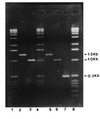Ocular cicatricial pemphigoid antigen: partial sequence and biochemical characterization
- PMID: 8962120
- PMCID: PMC26201
- DOI: 10.1073/pnas.93.25.14714
Ocular cicatricial pemphigoid antigen: partial sequence and biochemical characterization
Abstract
Ocular cicatricial pemphigoid (OCP) is an autoimmune disease that affects mainly conjunctiva and other squamous epithelia. OCP is histologically characterized by a separation of the epithelium from underlying tissues within the basement membrane zone. Immunopathological studies demonstrate the deposition of anti-basement membrane zone autoantibodies in vivo. Purified IgG from sera of patients with active OCP identified a cDNA clone from a human keratinocyte cDNA library that had complete homology with the cytoplasmic domain of beta 4-integrin. The sera recognized a 205-kDa protein in human epidermal, human conjunctiva, and tumor cell lysates that was identified as beta 4-integrin by its reaction with polyclonal and monoclonal antibodies to human beta 4-integrin. Sera from patients with bullous pemphigoid, pemphigus vulgaris, and cicatricial pemphigoid-like diseases did not recognize the 205-kDa protein, indicating the specificity of the binding. These data strongly implicate a role for human beta 4-integrin in the pathogenesis of OCP. It should be emphasized that multiple antigens in the basement membrane zone of squamous epithelia may serve as targets for a wide spectrum of autoantibodies observed in vesiculobullous diseases. Molecular definition of these autoantigens will facilitate the classification and characterization of subsets of cicatricial pemphigoid and help distinguishing them from bullous pemphigoid. This study highlights the function and importance of beta 4-integrin in maintaining the attachment of epithelial cells to the basement membrane.
Figures





References
-
- Ahmed A R, Hombal S M. Int J Dermatol. 1986;25:90–96. - PubMed
-
- Bernard P, Prost C, Aucoutuier P, Durepaire N, Denis F, Jean-Marie B. J Invest Dermatol. 1991;97:259–263. - PubMed
-
- Neiboer C, Boarsma D M, Woederma M J. Br J Dermatol. 1982;106:419–422. - PubMed
-
- Shimuzu H, Masunago T, Ishiko A, Matsumura K, Hashimoto T, Nishokawa T, Damloge-Hultsch N, Lazarova Z, Yancey K B. J Invest Dermatol. 1995;104:370–373. - PubMed
Publication types
MeSH terms
Substances
Grants and funding
LinkOut - more resources
Full Text Sources
Other Literature Sources
Medical

